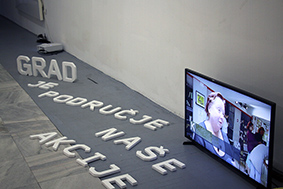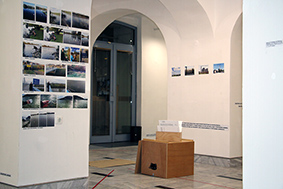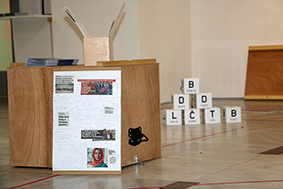|
| / Gallery Striegl, Sisak, 2019 / The publication for the exhibition was designed by Irena Frantal, text by Irena Bekić / EXHIBITION IMAGES >. |
|
/ During the "ART-ACT-BOX" performance with Ana Kreitmeyer the works in Gallery Striegl was installed by high school students:
Novela Perić / Rafaela Marić / Danijela Prskalo / Melita Hajdarović / Lucija Sušak / Klementina Kovačić / Iva Stanković. / PERFORMANCE >
|
| |
"ART-ACT-BOX: Performativeness of the Exhibition"
Installation based on the ART-ACT-BOX 27 dance performances
Gallery Striegl, Sisak, 13.-17.11.2018
|
text by Irene Bekić
HRVATSKI>
Getting out of the gallery and the museum into public space, communicating with the accidental audience, focusing on the process of art and not the objects produced, and on everyday situations and objects as possible art materials and points of departure: these are some of the basic determinants of conceptual art practices of the 1960s and 1970s. Referring critically to the art system and getting involved in the non-artistic field, they marked, not only a conceptual turn in art but opened the way to an artistic paradigm based precisely on overlapping with and merging into a non-art everyday life, like various forms of social artistic practices, critical and engaged art, Arte Útil and the like. There is no surprise then in the decision of Andreja Kulunčić, whose practice also represents one of the salient nodes of this paradigm, to have responded to the title topic of the collaboration museum project Performing the Museum by using as materials the conceptual works of the sixties and seventies that are to be found in the collections of the museums involved. These are works of the art groups TOK, the Group of Six Artists, KOD, Bosch+Bosch, Art & Language and the artists Pino Poggio, Bogdanka Poznanović and Lygia Clark. Seeing in them creative tactics that can today too be tools for the activation of the everyday and social engagement, with the contemporary dance artist Zrinka Užbinec, Andreja Kulunčić has devised the discursive dance project Performing the Exhibition: ART-ACT-BOX to be a part of the museum project in question. It will become a point of departure for further cooperative researches of the two artists, for testing out media and presentation formats.
The exhibition ART-ACT-BOX in Sisak will cover various facets of the whole of the project: their intentions, methods and analytical procedures, being realised in their totality as a complex space-time configuration.
Let us imagine for the purpose of the present writing some timeline on which to inscribe the parts of the project. At one end will be the graphic equivalent of the preliminary research process of the artist, and on the other, even though unbounded, the exhibition in Sisak. The imaginary line will cover a continuum that takes in performances, participants and visitors, solo and team-based research work, historical context and current reworkings of the pieces analysed, while in the gallery it will be spatialised in traces of previous productions, in imprints of the body and movement and in the gallery space itself as place for the overlapping of diverse, artistic and out of the artistic, aesthetics.
But let us return briefly to the work Performing the Exhibition: ART-ACT-BOX, the core of this project, one performance of it preceding the exhibition in Sisak.
This work, as mentioned above, is the response of Andreja Kulunčić to the invited theme Performing the Museum. Extracting material from the museum’s collections, its analytical and artistic transformation and switching it into non-artistic spaces, like libraries, retirement homes, culture centres, secondary schools and a psychiatric hospital are all literal translations of the theme of the title. Andreja Kulunčić, that is, does indeed “perform (and take out) the museum”, thereby problematising current practices of museum treatment, methods of communicating with the audience, and institutional and non-institutional presentational practices as strategic decisions in the transfer of knowledge and of the emancipatory potentials of art.
In a choreography that is based on research into selected conceptual practices of the sixties and seventies, the dancer with her body, movement and text acquaints the audience with the artistic intentions, principles and strategies, drawing it into the performance. She uses objects representing the essence of each individual work kept in the box created for this project. Reconstructing and reactivating one strategy after another, one work after another, the dancer and the audience together “set up the exhibition”. The regular roles are inverted: the performance ends at the moment when the “exhibition is set up”; the process of the performance is also the product of it, and the audience, taking part in the creative process installing the exhibition, cancels itself out, since after the exhibition is set up, when it should start, its role ceases.
The key aspects of the today historicised and museumised art practices of the sixties and seventies, body, text, movement, space, public space, are transposed and activated into contemporaneity through the art of the dance. Choreography is the measure of relations between thing, body and space, while the artistic methods cited are provided to the audience as a creative tool for the activation of their own quotidian and their social engagement.
Return to the gallery marks the return of the work to the artistic field. This is not unimportant, for it is precisely in the interference of the different systems that the transformative potential of the edge is maintained. The edge, that is, enables the opening out of the field and the establishment of new constitutive relations. The latter, apart from that, is also produced in the gallery space, since it is always organised and structured by a certain decision and in this respect is also performative (Fischer-Lichte) (1) . What happened outside the artistic field will acquire in the gallery set up its institutional framework. The multiple repetition of this trajectory in the ART-ACT-BOX project should not be seen as a self-referentially chasing its own tail. On the contrary, this constant transgression of the disciplinary threshold means an incessant opening of perspectives, a constant input of new elements and new relations, a new US created in the processes of perception (Rogoff, after Fischer-Lichte) (2) . The gallery space in this sense is a liminal space, and the experience of transition as process of transformation is an aesthetic experience (as against the non-aesthetic experiences in which transition is not experienced in its liminal character but just marks the path to some other objective) (3) .
In one section of the project, the authors handle going back into the gallery with the performance of the work Analysis of the Dance Material of the ART-ACT-BOX Project: Žitnjak Ateliers, the constitutive components of which are the dance materials that came into being by analysis of the preceding non-gallery project. This dance performance – a number of poetic images of shifted levels of reality, space and time, as well as of interferences and merging of the space of the performance, the performer and the audience – is a zone of experiment for both of the artists. With them, each from the perspective of her own area, they test out the possibility of dance in museums and galleries and the points where they converge, grasping from another angle now the topic “performing the museum” as well as the experimental thinking of the authors quoted above. The new collaboration at once builds, knocks down and changes the framework of what is known, while both authors put their own codes to the test. They test out and search for breakthroughs of their own practices within the newly created field. They creative poetic images, the magic of the performance, which they at the same time demolish, deconstruct and make strange with descriptions of the procedures, involving the audience, provoking the spatial borders, infiltrate themselves, educate…
In the Sisak exhibition a new work also comes into being in the return to the gallery. This time it is an installation built on the traces of the performance of ART-ACT-BOX, which was held before the exhibition was set up, including in addition the documentation and materials of the previous performances as imprints of the participant bodies.
From all of this one might ascertain the constitutive character of the artistic intention in the project. I am not thinking here of the concept of authorship, rather of the strategic role of authorial decision, methods and procedures. I shall thus employ the propositions of Boris Groys, who says that only from the perspective of production can art provide a bridge for the mingled positions of the biopolitical age – public and private, consumption and production, amateur and professional… Only when it is looked at from the viewpoint of production, he says, does the question of the politics of art exist, since it is a dimension that is not connected with aesthetic experiences of the viewer but of creative decisions (4) . In this sense, I would say, the project ART-ACT-BOX, like other works of Andreja Kulunčić, after all, represents a slippery ground for examination, doubt and belief that, on the one hand, art can provide tools on the road to transforming hegemonic representations, and on the other, belong to and create a zone of enchantment.
Irena Bekić
(1) E. Fisher-Lichte (2009) Estetika performativne umjetnosti or in English The Transformative Power of Performance: A New Aesthetics, Sarajevo, Zagreb: Šahinpašić.
(2) Isto, str. 246
(3) Isto, str. 247
(4) B. Groys (2010) Going Public. Berlin: Sternberg Press
|
|
| . |
|




